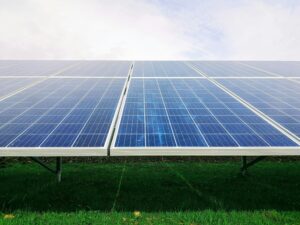Solar panels, those sleek and shiny devices that harness the power of the sun to generate clean energy, have become a common sight on rooftops and fields around the world. They offer a promising solution to combat climate change, reduce reliance on fossil fuels, and provide a renewable source of electricity. But amidst their rising popularity, a critical question looms: Are solar panels harmful to the environment? In this article, we will explore the potential environmental impacts of solar panels and shed light on this pressing concern.

Energy Production
Solar panels are a sustainable and environmentally friendly source of energy production. They have numerous benefits, including reduced greenhouse gas emissions, limited air pollution, and the conservation of fossil fuels.
Reduced Greenhouse Gas Emissions
One of the major advantages of solar panels is their ability to significantly reduce greenhouse gas emissions. Traditional electricity generation methods, such as burning fossil fuels, emit large amounts of carbon dioxide (CO2) and other greenhouse gases into the atmosphere. In contrast, solar panels harness the power of the sun to generate electricity without producing any emissions. By switching to solar energy, we can significantly reduce our carbon footprint and combat climate change.
Limited Air Pollution
Solar power is incredibly clean, and this contributes to the minimal air pollution associated with the use of solar panels. Unlike fossil fuel-based power plants, which release harmful pollutants such as sulfur dioxide, nitrogen oxide, and particulate matter, solar panels produce no emissions during operation. This not only improves air quality but also helps to prevent respiratory and cardiovascular diseases caused by exposure to polluted air. By adopting solar energy, we can enjoy cleaner, healthier air for ourselves and future generations.
Conservation of Fossil Fuels
Solar energy is a renewable resource, which means it will never run out. In contrast, the world’s reserves of fossil fuels, such as coal, oil, and natural gas, are finite and depleting rapidly. By utilizing solar panels, we can reduce our dependence on these limited resources and preserve them for essential applications such as transportation and manufacturing. Conserving fossil fuels is crucial for sustainable energy production and ensures that future generations will have access to clean and reliable energy sources.
Raw Material Extraction
While solar panels offer significant environmental benefits during their operation, their production does have some environmental implications. Let’s explore the impact of raw material extraction for solar panels, including mining, water consumption, and land use.
Mining Impact
The production of solar panels requires the extraction of various raw materials, including silicon, aluminum, silver, and other metals. Some of these materials, like silicon, are abundant and can be extracted through environmentally responsible techniques. However, the extraction of metals such as silver may involve mining processes that can have negative impacts on the environment. Mining can result in habitat destruction, soil erosion, and the release of toxic substances into waterways if not properly managed. It is essential to prioritize sustainable mining practices and minimize the environmental footprint associated with raw material extraction.
Water Consumption
Water is a crucial resource, and its consumption during the production of solar panels should be taken into consideration. The manufacturing process, in particular, requires significant amounts of water for cleaning, cooling, and other purposes. It is important for solar panel manufacturers to implement water management strategies that aim to reduce consumption and minimize the potential strain on local water resources. Investing in technologies such as recycling and water-efficient production methods can help mitigate the impact of solar panel production on water scarcity concerns.
Land Use
The installation of solar panels requires adequate land availability and suitable locations for optimal sunlight exposure. While solar panels can be installed on various types of land such as rooftops, deserts, and open fields, their widespread adoption may require substantial land use. This can raise concerns about potential land conversion and habitat fragmentation. To address this, it is important to prioritize the utilization of already disturbed or non-environmentally sensitive areas for solar panel installations. Additionally, integrating solar panels into existing infrastructures, such as buildings and parking lots, can help minimize the need for additional land use.

Manufacturing Process
The manufacturing process of solar panels plays a significant role in their overall environmental impact. From energy-intensive production to chemical usage and waste generation, understanding these aspects is crucial to make informed decisions regarding solar panel adoption.
Energy Intensive
The production of solar panels requires a considerable amount of energy, primarily derived from conventional sources like fossil fuels. This irony raises concerns about the initial carbon footprint associated with solar panel manufacturing. However, it is essential to consider the long-term benefits of solar panels, as they offset the initial energy input by generating clean electricity throughout their lifespan. To mitigate the environmental impact of the manufacturing process, solar panel manufacturers should strive to increase energy efficiency and transition towards renewable energy sources for powering their production facilities.
Chemical Usage
Certain chemicals are used in the manufacturing process of solar panels, which can have environmental implications if not properly managed. For instance, the synthesis of silicon wafers for solar cells involves the use of hazardous substances such as hydrochloric acid and nitric acid. It is crucial for manufacturers to adhere to stringent regulations and industry standards to prevent the release of these chemicals into the environment. Responsible chemical handling, waste treatment, and recycling practices can help minimize the potential negative effects on the environment and human health.
Waste Generation
Solar panel manufacturing inevitably generates waste, including both hazardous and non-hazardous materials. This waste can consist of scrap materials, rejected or defective panels, and byproducts of the manufacturing process. Proper management of this waste is essential to prevent pollution and minimize the environmental impact. Implementing waste reduction strategies, such as optimizing production processes to minimize scrap materials, and establishing recycling programs for end-of-life panels, can contribute to a more sustainable solar panel production cycle.
Transportation
The transportation of solar panels and their components also has environmental implications. Understanding the energy consumption, emissions, and logistical aspects of transportation is important for assessing the overall environmental impact of solar panel systems.
Energy Consumption
Transporting solar panels from manufacturing facilities to installation sites requires energy, primarily in the form of fossil fuels. To minimize the energy consumption associated with transportation, it is essential to optimize logistics and distribution networks. Efficient route planning, the use of low-emission vehicles, and consolidated shipments can help reduce the carbon footprint of solar panel transportation.
Emissions
The transportation of solar panels can contribute to greenhouse gas emissions, as vehicles emit carbon dioxide and other pollutants during operation. To mitigate these emissions, solar panel manufacturers and installers can consider utilizing environmentally friendly transportation methods, such as electric vehicles or adopting greener fuels. Additionally, the closer proximity of manufacturing facilities to installation sites can help reduce the distance traveled and, consequently, the emissions associated with transportation.
Logistics
Efficient logistics play a crucial role in minimizing the environmental impact of transporting solar panels. Optimizing the supply chain, including inventory management, warehousing, and transportation routes, can result in reduced energy consumption and emissions. Collaborative efforts between manufacturers, installers, and logistics providers can help streamline operations and maximize sustainability throughout the solar panel distribution process.

Installation and Decommissioning
The installation and decommissioning of solar panel systems also have environmental considerations. Understanding the resource usage, waste management, and potential environmental impact at these stages is vital for evaluating the overall sustainability of solar panel installations.
Resource Usage
The installation of solar panels requires various resources, such as mounting structures, cables, and connectors. It is important to optimize the use of these resources by selecting durable and recyclable materials. Additionally, incorporating designs and installation practices that minimize resource consumption can contribute to reducing the environmental impact of solar panel installations.
Waste Management
During the installation and replacement of solar panels, waste is generated in the form of old panels, packaging materials, and construction debris. Implementing proper waste management practices is crucial to prevent pollution and enable the recovery or recycling of valuable materials. Recycling initiatives for end-of-life panels can help minimize waste and reduce the environmental footprint associated with solar panel decommissioning.
Environmental Impact
The installation of solar panel systems can have localized environmental impacts, such as soil disturbance, vegetation removal, or alterations to the natural landscape. To mitigate these effects, it is essential to prioritize environmentally sensitive installation practices. Careful site selection, adherence to restoration plans, and engaging in community consultation can contribute to sustainable solar panel installations that minimize environmental disruption.
End-of-Life Management
The end-of-life management of solar panels is an important aspect of their overall environmental impact. By considering recycling options, waste disposal challenges, and addressing the presence of toxic materials, we can ensure the responsible and sustainable disposal of decommissioned solar panels.
Recycling Options
Solar panels contain valuable materials that can be recycled and reused. However, the recycling infrastructure for solar panels is still developing, and access to recycling facilities may be limited in some regions. It is crucial to invest in research and innovation to improve existing recycling technologies and establish effective collection and recycling systems. Proper recycling of solar panels can help recover valuable resources, minimize waste, and reduce the need for extracting raw materials.
Waste Disposal Challenges
The disposal of decommissioned solar panels presents challenges, especially if recycling options are not readily available. In some cases, solar panels may end up in landfills, where their valuable resources go to waste, and the potential for leaching of hazardous substances exists. Regulations and initiatives that encourage responsible waste disposal practices are needed to ensure the environmentally sound management of end-of-life solar panels.
Toxic Materials
Although solar panels are generally considered safe, they do contain small amounts of potentially toxic materials. For instance, some solar panels include cadmium or lead compounds. While these materials are encapsulated within the panel, proper handling and disposal procedures are necessary to prevent potential environmental or health risks. By ensuring adequate safety regulations and promoting responsible waste management practices, we can mitigate the potential adverse effects associated with toxic materials in solar panels.
Biodiversity
The expansion of solar panel installations can have implications for biodiversity. Understanding the potential impacts on habitat fragmentation, wildlife, and ecosystems is critical for sustainable solar panel deployment.
Habitat Fragmentation
Solar panel installations, especially large-scale arrays, can lead to the fragmentation of habitats for various species. This fragmentation can disrupt natural migration patterns, restrict access to food and water sources, and isolate populations. It is essential to consider biodiversity conservation in the planning and design of solar panel installations to minimize their impact on wildlife habitats.
Impact on Wildlife
The presence of solar panels can have both positive and negative impacts on wildlife. On one hand, solar panel arrays can provide elevated platforms that attract birds, creating potential collision risks. On the other hand, solar farms can offer new opportunities for habitat creation and ecological restoration if properly designed. Strategic planning, incorporating wildlife-friendly designs, and implementing appropriate mitigation measures can help maximize the benefits while minimizing potential negative impacts on wildlife.
Effects on Ecosystems
Solar panel installations, especially if located in environmentally sensitive areas, may impact ecosystems. Alterations to the natural landscape, changes in water flow patterns, or shading effects can affect local flora and fauna. By conducting thorough environmental assessments, engaging in habitat restoration initiatives, and adhering to best management practices, we can ensure that solar panel installations have minimal adverse effects on ecosystems.
Water Resource Usage
Solar panel systems have water usage implications, mainly during their operation and the cooling requirements associated with their functioning. Understanding the cooling requirements, water scarcity concerns, and potential disturbance to ecosystems is crucial for making sustainable choices regarding solar panel deployment.
Cooling Requirements
During operation, solar panels can generate heat. To maintain optimal performance, some solar panel systems require cooling mechanisms, often utilizing water. It is important to consider alternative cooling methods that minimize water consumption and avoid the strain on local water resources. Evaporative cooling techniques, such as using air or dry cooling methods, can reduce water usage and contribute to the sustainability of solar panel systems.
Water Scarcity Concerns
Water scarcity is a growing global concern, and the water requirements of solar panel systems should be evaluated within this context. In regions already experiencing water scarcity or facing potential future water shortages, it is essential to prioritize water-efficient technologies and practices for solar panel installations. Implementing measures to reduce water consumption and exploring alternative cooling technologies can help alleviate the potential strain on limited water resources.
Ecosystem Disturbance
Solar panel installations, particularly in water-stressed regions, may require the use of bodies of water for cooling purposes. This usage can disrupt local ecosystems, impacting aquatic flora and fauna. To minimize disturbances, it is important to consider the ecological integrity of water sources and implement mitigation measures that protect and restore affected ecosystems. Engaging in environmental impact assessments and working closely with local stakeholders and regulatory bodies can facilitate the development of sustainable solar panel projects that prioritize ecosystem conservation.
Visual Impact
The visual impact of solar panels is a consideration often raised when discussing solar panel installations. Understanding aesthetics, their presence in conservation areas, and community acceptance is crucial for successfully integrating solar panels into the built environment.
Aesthetics
The appearance of solar panels is a subjective matter, with some individuals finding them aesthetically pleasing, while others may have concerns about their visual impact. Advances in solar panel technologies, such as incorporating transparent panels or integrating them into building elements, can help improve their visual appeal. Additionally, considering the design and layout of solar panel installations, potentially hiding them from direct view, can help minimize their visual impact.
Conservation Areas
Solar panel installations in conservation areas raise unique challenges. While it is important to transition towards sustainable energy sources, it is equally crucial to protect ecologically sensitive areas and biodiversity hotspots. Striking a balance between renewable energy development and conservation efforts is possible through mindful planning, stakeholder engagement, and adherence to strict environmental regulations. Collaborative efforts among conservationists, energy developers, and local communities can help identify suitable locations for solar panel installations without compromising the integrity of conservation areas.
Community Acceptance
Public acceptance plays a vital role in the successful deployment of solar panel systems. Engaging with local communities and addressing their concerns, such as visual impact or perceived property devaluation, is essential for fostering support and encouraging the adoption of solar energy. Educating communities about the environmental benefits, economic advantages, and long-term sustainability of solar panels can help overcome potential resistance and promote community acceptance.
Efficiency and Longevity
Examining the efficiency and longevity of solar panels is critical for determining their overall environmental impact, as well as financial viability. Evaluating energy payback time, solar panel lifespan, and maintenance and disposal considerations provides insights into the sustainability of solar panel systems.
Energy Payback Time
Energy payback time refers to the period required for a solar panel system to generate the same amount of energy that was used in its manufacturing and installation. The energy payback time varies depending on various factors, such as the technology used, geographical location, and local solar resource availability. Advances in solar panel technology and increasing energy efficiency have significantly reduced the energy payback time, making solar panels a viable long-term renewable energy solution.
Solar Panel Lifespan
The lifespan of solar panels is an important consideration for their environmental impact. Most solar panels come with warranties ranging from 20 to 25 years, but their actual lifespan can exceed these periods. Quality manufacturing, proper installation, and regular maintenance can extend the lifespan of solar panels, ensuring they continue to generate clean energy for many years. Maximizing the longevity of solar panels reduces the need for frequent replacements and minimizes their overall environmental footprint.
Maintenance and Disposal
Maintaining and disposing of solar panels responsibly is crucial for sustaining their environmental benefits. Regular maintenance, such as cleaning panels to maximize efficiency and inspecting for potential issues, ensures optimal performance throughout their lifespan. When disposing of decommissioned solar panels, recycling should be prioritized to recover valuable materials and minimize waste generation. By adhering to proper maintenance practices and establishing recycling programs, we can ensure the long-term sustainability of solar panel systems.
In conclusion, solar panels offer numerous environmental benefits, from reduced greenhouse gas emissions and limited air pollution to the conservation of fossil fuels. While there are some environmental considerations associated with their production, transportation, installation, and disposal, taking a holistic and responsible approach can mitigate these impacts. By prioritizing sustainability, engaging in research and innovation, and promoting collaboration among stakeholders, we can harness the power of solar energy while minimizing harm to the environment.




